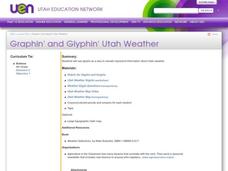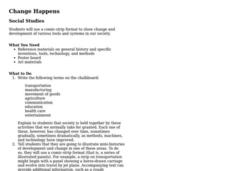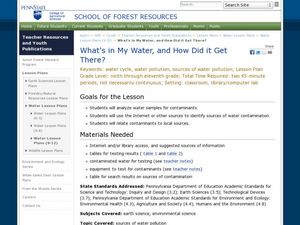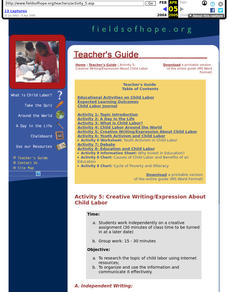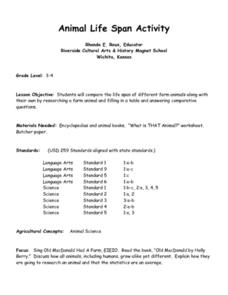Curated OER
Graphin' and Glyphin' Utah Weather
Fourth graders use glyphs as a way to visually represent information about Utah weather. These nonverbal representations help students collect and interpret data in a visual format.
Curated OER
Change Happens
Students research different inventions that have changed over time. They use a comic strip format to illustrate how an area has changed. They share their comic strips with the rest of the class.
Curated OER
Watershed Investigations
Learners explore the components of a watershed and the factors that affect it. They read a topographical map and use geometry to determine the area of a watershed. Students estimate the volume of a body of water and perform runoff...
Curated OER
Light Plants and Dark Plants, Wet Plants and Dry Ones
Students plant sunflower seeds in plastic cups, and once germinated, these are exposed to different conditions of light levels and/or soil moisture contents. Students measure growth of the seedlings every few days using non-standard...
Curated OER
What Trickles Down?
Students explore different levels of permeability and compare the permeabilities of several different materials. They are introduced to the basic concepts of building design, landscape architecture, and environmental pollutant transport....
Curated OER
Identifying Various Roles of Women
Eighth graders view pictures of various women from Santa Clara County history. They discuss the occupational roles of the women and try to identify occupational roles they are familiar with. They answer questions on a Bio Brief...
Curated OER
Know Your Watershed
Students investigate the importance and the location of their own watershed by visiting and EPA website and also work in groups to create an action plan on how to protect their local watershed.
Curated OER
What's in My Water, and How Did it Get There?
Students analyze water samples to see the contaminants and then use the Internet to find the sources of the contamination. In this investigative water lesson plan students analyze water and work together to solve the mystery of...
Curated OER
Taking a Stand: Pros and Cons of Forest Fires
Students explore the pros and cons of forest fires. In this science instructional activity, students research the ecological implications of forest fires. Students record their findings in journals and compose a persuasive e-mail to...
Curated OER
Grab Quick and Easy Snacks
In this healthy eating worksheet, students complete a maze. Students avoid the pictures of the "dead end" snacks high in sugar, fat and calories. There is a tuna pita sandwich recipe on the page.
Curated OER
A Land of Milk and Honey
Ninth graders examine the term multiculturalism. In this Cross Curricular History and Social Studies lesson, 9th graders analyze a video clip. Students investigate the requirements for becoming a citizen in Australia.
Curated OER
Cambodian New Year
Students compare and contrast the New Year celebration in Cambodia to the celebration in the United States. They mathematically determine the amount of beans added to the "mountain" during the three day celebration.
Curated OER
Placing Deerfield in a National Context
Eleventh graders understand that world events brought important changes that impacted Deerfield. Students use information gained from this and other periods to develop a continuum showing the growth of the Deerfield community.
Curated OER
Activity 5: Creative Writing/Expression About Child Labor
Students research child labor using Internet resources. They present the information in a creative writing piece and post it on Chalkboard.
Curated OER
What if the Mormons had not come to Utah?
Fourth graders use critical thinking, evaluation, and geography skills to find alternative locations that Brigham Young could have taken the Mormons to settle.
Curated OER
When Rice Was King
Pupils examine the origins of rice production in the South. They identify the steps involved in rice cultivation, examine photos of plantation life, conduct interviews, and research the economic base of their own community.
Curated OER
It All Starts With a Seed
Students use laboratory equipment safely. They identify structures in a seed. They distinguish between monocots and dicots. They search for information using the computer.
Curated OER
Seed to Market
Students research using a variety of materials and technology. They explain the specifics of growing crops. They use mathematics in common business calculations.
Curated OER
Animal Life Span Activity
Students study and compare the life span of farm animals with their own. They research a farm animal, complete a table and answer comparative questions. They work in jigsaw format groups.
Curated OER
Impact of the End of World War II on Japan
Ninth graders examine and discuss reasons United States occupied Japan after surrender in World War II, view photographs of Japan at end of War and explore how U.S. occupation affected Japan's political, economic, and social systems, and...
Curated OER
GPS Art
Students design their own logo or picture and use a handheld GPS receiver to map it out. They write out a word or graphic on a field or playground, walk the path, and log GPS data. The results display their "art" on their GPS receiver...
Curated OER
Selecting a State Fish
Young scholars work in groups to select a state fish for their state. They review reference materials to make a list of state characteristics and select a fish that best exemplifies the state.
Curated OER
Greek Theatre Styles
Seventh graders are introduced to the different styles of Greek theatres. As a class they discuss the level of sophistication in different areas and the purpose of the theater. To end the activity, they practice the techniques of the...
Curated OER
What Can You Do?
Students explore reasons for the destruction of the wetlands and identify ways people can help protect them. They create and design a wetlands conservation poster to be presented to the class.


